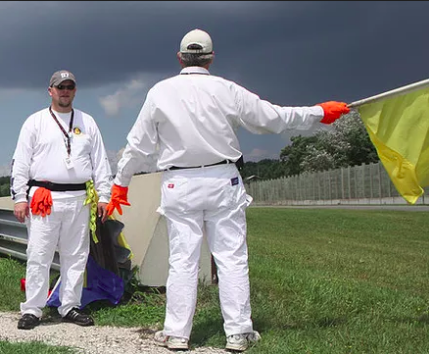Flags are an essential part of any Motorsports event. Flags are the only way in which the Facility, Coordinators, Teams, etc can communicate from the sidelines to the drivers. Flags convey the commands or information indicated below. They must be obeyed immediately and without question.
Cautions

The solid yellow flag, or caution flag, universally requires drivers to slow down due to a hazard on the track, typically an accident, a stopped car, debris or light rain. However, the procedures for displaying the yellow flag vary for different racing styles and sanctioning bodies.
- A single waved flag denotes a hazard on the racing surface itself.
- A single stationary flag denotes a hazard near the racing surface.

- Two flags waved simultaneously denotes a hazard that wholly or partly blocks the racing surface. This informs the driver that there may be marshals on the track and to prepare to stop, if necessary.

- When the safety car is on the circuit, all flag points will display a White flag. When flag points are under radio control, this will happen immediately, otherwise, the White flag is displayed when the safety car comes round for the first time. This is accompanied by a waved yellow flag. Standard yellow flag conditions apply to the whole circuit; notably, overtaking is completely forbidden.
Hazardous Conditions

The red and yellow striped flag, or debris flag is displayed stationary at local flag stations to indicate that track conditions have changed due to substances on the track which could reduce grip or cause a car to lose control. Generally oil, coolant, small pieces of debris or sand are the hazards. It can also be "rocked" back and forth (but not waved) to indicate a small animal on the racing surface. Many organizations will display this flag for only two laps, after which the changed surface is considered to merely be "part of the track".

A mechanical black flag is a black flag with an orange disc (aka "the meatball") in its center indicates that a vehicle is being summoned to the pits due to serious mechanical problems or loose bodywork that presents a risk to other competitors.
Halt Conditions

The solid (furled) pointed black flag is used to summon a driver to the pits. It is usually associated with a penalty imposed on the driver for disobeying the rules, but may also be used when a car is suffering a mechanical failure, leaking fluid, exhibiting damage such as loose bodywork, loose hood, dragging bumper, or any other damage that could potentially become a hazard to the driver or other competitors.

There are some instances where a Black Flag will be shown inconjunction with the White Flag, this is to indicate to all drivers coming back to the pits, that there is an emergency vehicle present in the area, but their actions remain guided by the black flag rules: return to the pits.
Session Stop Conditions

The solid red flag is displayed when conditions are too dangerous to continue the session. Depending on the series and the circumstances, the cars are typically directed to proceed immediately to pit road, or to stop at a specific spot on the track (the closest visible corner station). In some severe cases the cars might be required to stop immediately where they are.
 >>
>> 
Generally, when Red Flag conditions are lifted, they are immediately followed by a Black Flag requesting that all drivers return to the pits.
Guidelines on Stopping a Session
When it is necessary to stop a session, the Race Director or Chief Steward may do any of the following:
- Order a black flag with an “ALL” sign at Start (this sign may also be shown at additional stations elsewhere
on the course) and a black flag at all other flag stations around the course. - Order a red flag at Start and all other flag stations. Further instructions will be conveyed by officials.
- Order the checkered flag to be displayed to the lead car if at least 50 percent of its scheduled time or distance has been completed.
Passing Flags

A solid blue flag, sometimes with a diagonal yellow, orange, or red stripe (seen below) -



informs a driver that a faster car is approaching and that the driver should move aside to allow one or more faster cars to pass. During a race, this would only be usually shown to a driver who is getting lapped but during practice or qualifying sessions, it could be shown to any driver. In most series, the blue flag is not mandatory—drivers obey it only as a courtesy to their fellow racers. As such, it is often referred to as the "courtesy flag".
Emergency Conditions

The white flag indicates the presence of an official car or a competitor moving at below normal speed in the section of track covered by the flag station.

When the safety car is on the circuit, all flag points will display a White flag. When flag points are under radio control, this will happen immediately, otherwise, the White flag is displayed when the safety car comes round for the first time. This is accompanied by a waved yellow flag. Standard yellow flag conditions apply to the whole circuit; notably, overtaking is completely forbidden.

A white flag with coupled red cross, to indicate medical attention is required near the marshalling post. Can also mean an ambulance is on the course (generally a red cross is followed by the race being "red flagged")
End of Session / Race

The checkered flag is displayed at the start/finish line to indicate that the race is officially finished. At some circuits, the first flag point will display a repeat checkered flag (usually on the opposite side of the circuit). Upon seeing the checkered flag and crossing the finish line, drivers are required to slow to a safe speed, and return to their garage or the paddock.
Interested in becoming a flagger? Learn more


